Snapchat: shaking up social media
Snapchat quickly rose to prominence as a leading social media app that allows you to send messages, photos and videos to anyone you choose. The catch is that it only lasts for a total of ten seconds. It has most recently established itself into a successful business for both news and advertising purposes as well.
One of the most attractive features of Snapchat is the fact that it is different from perfectly curated, glamorous Facebook and Instagram feeds. It breaks the glossy, inauthentic image people invest in creating on these heavily customizable social media platforms. Millennials along with older demographics will empathize with me about the overwhelming amount of messages they receive from friends and acquaintances asking you to ‘ like’ their most recent posts. Instagram is an especially aggressive cross between a popularity and photo contest, where those that have never had an interest in creativity and the meanings behind photography suddenly become experts in the field.
Those concerned with the amount of likes they receive will constantly monitor how many followers they have, which picture got the most likes, and most importantly, they’ll try to figure out who did not like their photos or follow them back. It’ s a competitive world out there, and if you have a friend that does not follow you back–well, bye Felicia!
Snapchat is much less structured than that. There’s nothing to “like” on Snapchat, and the creators purposefully cultivate this feature. The emphasis on real-time story telling provides authentic glimmers into people’s lives.
The app excels at providing a window into the lives of people we care enough to follow. Because unlike other social media platforms, you have to make an effort to add people instead of choosing from a readily available list of suggested friends. It allows you to choose content that you feel is relevant to you. No longer do you have to see posts from people you don’t consider friends in real life and therefore have minimal interest in hearing about. It is the end point of rapid scrolling through a Facebook or Instagram feed in search of something personally interesting or amusing.
Snapchat is all about cultivating conversation, and provides a break from the isolation of 21st century lives. But most simply and importantly- it’ s fun. The funky filters and goofy stickers breathe some refreshing air into our daily routines. And you know what? There are actually careers people have created through the popularity of their creative use of Snapchat features. If you don’ t believe me, check out Geeohsnap and Cakes1toDough1.
The company’s consistent focus on providing entertainment has helped to expand its popularity. The dive into global stories about Earth Day, or even putting a spotlight on the annual Camel Market in India really creates a sense of community between the billions of people around the world. It shatters barriers in the most unconventional form: entertainment.
Yet despite the general impression, this app is not only important for teenagers, but it is also a billion-dollar advertising platform. Many companies have the opportunity to advertise their product through lenses, which has created an advertising product that people actually want to see, use and share. Take, for instance, the Sia lens, where users were clad with the iconic style of the singer, playing a huge role in boosting the fame of this celebrity.
Snapchat has seemingly transcended the usual social media formula: endless scrolling about people and things you really don t care about. It allows you to select who and what you want to follow along with a fun interface that makes everyone’s lives seem a little more interesting. But most of all, Snapchat—with various geofilters and the ability to contribute to app-wide stories—has created a sense of social media community. Despite its entrance into the world of social media advertising, it seems that Snapchat has enough of an appeal that this won’ t cause much of a disruption for its millions of users.
Image courtesy of Vocativ
